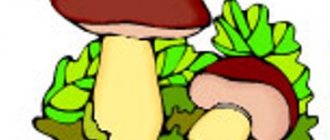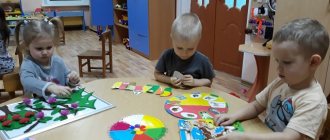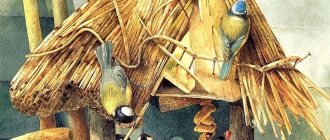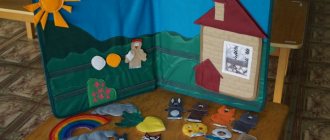Long-term plan for introducing nature to the first junior group
Kulkova Yulia
Long-term plan for introducing nature to the first junior group
September
Topic 1. “Carrot from the Bunny”
.ABOUT.
A. Solomennikova. Introduction to nature in kindergarten . Second early age group . pp. 20-21. Expand children's understanding of vegetables (carrots)
.
Develop a friendly attitude towards others. Toy bunny, whole and grated carrots. 1. Verbal. 2. Visual. 3. Gaming. Examination of vegetables and fruits, illustrations of them; targeted walk to the garden; modeling carrots; p/i “The little white bunny is sitting”
.1. Joint walks to the garden. 2. Joint work in the garden.
October. Topic 2. “Leaf fall, leaf fall, yellow leaves are flying...”
.
O. A. Solomennikova. Introduction to nature in kindergarten . Second early age group . pp. 21-23. Give children a basic understanding of autumn changes in nature . To develop the ability to determine the weather by external signs and consistently, according to the season, dress for a walk. Learn to identify the trunk, branches and leaves of trees. Doll Masha and clothes for her. 1. Verbal. 2. Visual 3. Game. Observation of wind, rain, sun, sky. Looking at autumn leaves. Games “We are autumn leaves”
;
"Sun and Rain"
. Drawing autumn leaves. Conversation about the signs of autumn.
November. Topic 3. “Fish swims in water”
.
O. A. Solomennikova. Introduction to nature in kindergarten . Second early age group .
pp. 23-24. Give children a basic understanding of aquarium fish. Generate interest in the inhabitants of the aquarium. Aquarium with fish, food for them. 1. Verbal. 2. Visual. 3. Gaming. Looking at shells and pebbles in an aquarium; finger game “Fish swims in water”
. Looking at illustrations of aquarium fish.
December. Topic 4. “At the feeder”
.
O. A. Solomennikova. Introduction to nature in kindergarten . Second early age group . pp. 24-26. Give children a basic understanding of bird feeders. Develop a kind attitude towards birds and a desire to take care of them. Bird feeder, envelope with letter, bird food. 1. Verbal. 2. Visual. 3. Gaming. Observation of birds flying to the site; p/i “Birds are flying”
,
“birds in nests”
,
“Sparrows and a car”
.
Drawing “Bird food”
.
January. Topic 5. “Snowman and Christmas tree”
.
O. A. Solomennikova. Introduction to nature in kindergarten . Second early age group . pp. 26-27. Expand children's understanding of trees; show the properties of snow, form a friendly attitude towards the surrounding world. Snowman toy; spruce (growing on the site)
.
1. Verbal. 2. Visual. 3. Gaming. Learning poems about nature ; making a snowman. Drawing "Herringbone"
.
February. Topic 6. “Kitten Fluff”
.
O. A. Solomennikova. Introduction to nature in kindergarten . Second early age group . pp. 27-29. Give children an idea of domestic animals and their babies; introduce you to Russian life; develop a kind attitude towards animals. Panorama of a Russian hut, stove, toy kitten. 1. Verbal. 2. Visual. 3. Gaming. Examination of illustrations depicting domestic animals, nursery rhyme “The cat went to the market”
, poem by V. Berestov
“Kitten”
.
Drawing “Tangle for a kitten”
.
March. Topic 7. “Cockerel and his family”
.
O. A. Solomennikova. Introduction to nature in kindergarten . Second early age group .
pp. 29-31. Expand children's understanding of domestic animals and their characteristics. Create a desire to take care of poultry. Panorama of the poultry yard, toys cockerel, hen and chickens. Plasticine, modeling boards, napkins. 1. Verbal. 2. Visual. 3. Gaming. 4. Practical. Playing with toys, reading the poem “Cockerel” by
. Pet monitoring.
April. Topic 8. “Sunny, sunshine, look out the window”
.
O. A. Solomennikova. Introduction to nature in kindergarten . Second early age group . pp. 31-33. Give children ideas about spring changes in nature . To develop interest in natural . Learn to convey the image of the sun in a drawing. Flannelgraph, silhouettes for laying out a spring landscape, a large sheet of paper with a drawn sun circle, brushes, a water jar, napkins. A cloud and an umbrella drawn and cut out of paper. 1. Verbal. 2. Visual. 3. Gaming. 4. Practical. Looking at illustrations of the sun, reading the nursery rhyme “Sun, Bucket”
.
Games “Sunny Bunny”
,
“Sunshine and Rain”
.
Drawing the sun. Observing spring changes in nature .
May. Topic 9. “Here and here, here and here dandelions bloom...”
.
O. A. Solomennikova. Introduction to nature in kindergarten . Second early age group . pp. 33-35. To form children's ideas about dandelions, teach them to identify the characteristic features of a dandelion, and name its parts. Develop a desire to respond emotionally to the beauty of the surrounding nature .
Masha doll, dandelions. 1. Verbal. 2. Visual. 3. Gaming. Looking at illustrations of dandelions. Observing spring changes in nature .
Abstract of GCD in junior group 1 on the topic: Walk through the autumn forest
Lesson in the first junior group “Walk through the autumn forest.
Visit the Hedgehog" GOAL: 1. To introduce children to the features of living nature. 2. Learn to understand the behavior and habits of animals. 3. Cultivate an interest in nature, a kind attitude towards all living things. 4. Expand your understanding of the lifestyle of wild animals in the fall (how they prepare for winter). 5. Strengthen the ability to compose various phrases and short simple sentences. VOCABULARY: 1. Fly agaric;
2. White mushroom; 3. Leaf fall; 4. Edible, inedible; 5. Yellow, green, red; 6. Cloudy, cold, golden autumn. PROGRESS OF THE CLASS
The group is decorated with autumn leaves (yellow, red, green).
The teacher asks a riddle. Educator: Guys, I’m now going to tell you a riddle, and you listen carefully. If the leaves on the trees have turned yellow, If birds have flown to a distant land, If the sky is gloomy, if it is raining. This time of year, what is it called? (Autumn) Children: Autumn. Educator: Do you want to go visit the mistress of autumn? How to find the way? Look, maybe autumn has left us its clues? Leaves were laid out and hung along the way. There are environmental posters hanging on the walls (bugs, nest, lily of the valley, anthill, stream). Children enter the group.
Educator: Guys, what time of year is it now? Children: Autumn. Educator: What is autumn like? Children: Golden, rainy, cloudy. Educator: Guys, come to me, look at what beautiful pictures are drawn. The forest is washed with warm rain, Leaves and grass whisper, And the trunks raise the crown of the green oak grove to the sky. Having chosen an observation post in the branches, Rejoicing in the shower in July, As if on a swing, a thrush swings With a drop of sun on its beak. (S. Makhotin) A stomp is heard. Educator: Guys, hear stomping. Who goes? Guess the riddle. There are needles on the back, long and prickly. And he curls up into a ball - There is no head, no legs. Children: Hedgehog. Educator: Hedgehog, what's your hurry? Hedgehog: It's cold. Frozen. Educator: Hedgehog, do you want to play with us? You'll warm up. Guys, let's warm up the hedgehog. Guys, you will all be mice, and I will be a hedgehog. P/I Game “Hedgehog” A hedgehog walked along the path (children walk one after another) And found a fungus in the grass (children bend forward and squat, “take” an imaginary mushroom with their hands) He attached it to needles (children stand up and “put” the mushroom) And headed home. (children walk after each other) A hedgehog ran along the path (children run after each other) Found an apple in the grass (children bend forward, squat and “take” an imaginary apple with their hands) Put it on needles (children stand up and “put” the apple on their heads - “needles”) And he hurried home again. (children run after each other) The hedgehog came to his home, (children start walking and stop) He opened the door in the pantry. (they open the doors with both hands) Folded the mushroom and apple - (they remove the mushroom and apple from the head and put them, squatting, halfway - 2 times) He lived through the winter without any hassle. (stand up and show the “class” sign with both hands) Teacher: [/b Hedgehog, are you warm? Hedgehog: Thanks, guys! Got warm. Guys, yours is so beautiful. Such beautiful leaves. Can you help me and collect a bouquet. Educator: Guys, let's help the hedgehog. Educator: The autumn wind blew. Leaves flew from the trees. The leaves have begun to fall. What is it called when the leaves fly? Children: Leaf fall. Outdoor game "Falling Leaves". Educator: Guys, now let's collect the leaves in a basket and give them to the Hedgehog, let him decorate his house. A bouquet of leaves is handed over to a hedgehog. Hedgehog: Thanks, guys! Now I won't freeze. Educator: And we know a song about you, Hedgehog. Song "Hedgehog". Educator: Hedgehog, do you really like mushrooms? Hedgehog: Very much. But I don't know what mushrooms to pick. Educator: And we, Hedgehog, will help you. The teacher shows two pictures with mushrooms: fly agaric - inedible, white - edible. Educator: What is shown in the picture? Children: Mushrooms. Educator: What are the mushrooms called? Which of these mushrooms is edible? Will we collect fly agaric? Children: No. Educator: Why? Children: Not edible. Children collect edible mushrooms in a basket and give them to the hedgehog. Hedgehog: Thank you guys very much! They helped me put together a beautiful bouquet and prepare food for the winter. For this I will treat you to apples. The hedgehog treats the children with apples, says goodbye and goes into the forest.
We recommend watching:
Summary of a lesson on speech development for the 2nd junior group. Pleshcheev “Autumn” Summary of OOD in the junior group with presentation. A Journey to the Autumn Forest Notes on social and communicative development in the 2nd junior group on the topic: Autumn Notes on social and communicative development in the 2nd junior group on the topic “Autumn has come to us”
Similar articles:
Lesson notes for the younger group. Broken applique “Autumn leaves”



